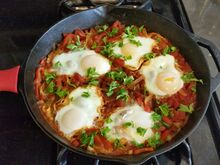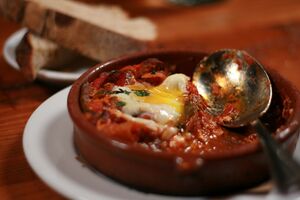شكشوكة
 Shakshouka in a cast iron pan | |
| النوع | طبق رئيسي |
|---|---|
| المنطقة أو الدولة | تونس، مصر، وبلدان شرق أوسطية أخرى. |
| المكون الرئيسي | البيض، الطماطم، الفلفل، زيت الزيتون |
| |
الشكشوكة، هو طبق شرق أوسطي يتكون من البيض المطهو في صلصة الطماطم وزيت الزيتون والفلفل والبصل والثوم، وعادة ما يتبل بالكمون، البابريكا، والفلفل الأسود. بحسب خوان ناثان، يرجع أصل الشكشوكة إلى شمال أفريقيا العثمانية في منتصف القرن السادس عشر بعد إدخال الطماطم للمنطقة بواسطة هرنان كورتيس كجزء من التبادل الكولمبي.[1]
التسمية
The word shakshouka (العربية: شكشوكة) is a Tunisian Arabic[2] term for "a mixture".[3][4][5][6] According to Mary Fitzgerald, the word is allegedly believed to come from the Berber languages,[7] although most sources agree on the term's Arabic origin. In Morocco, it is referred to as bīḍ w-maṭiša (بيض ومطيشة "egg and tomato").[8]
التاريخ
The origin of the dish remains a matter of some controversy with competing claims of Algerian, Libyan, Moroccan, Tunisian, Egyptian, Turkish, and Yemeni origins.[9][10] Tomatoes and peppers are notably New World ingredients that only became common ingredients in later centuries after the Columbian exchange.
Tunisian Jewish immigrants brought the dish to Israel in the 1950s and 1960s, though it only became popular on menus in the 1990s.[7][11]
الأنواع

Many variations of the basic sauce are possible, varying in spice and sweetness. In the tunisian gastronomy, some cooks add preserved lemon, salty sheep milk cheeses, olives, harissa or a spicy sausage such as chorizo or merguez.[12] Shakshouka is made with eggs, which are commonly poached but can also be scrambled, like in the Turkish menemen.[13][11]
In Algeria, shakshouka is commonly eaten as a side dish, and there are countless variations of it, each with their own unique blend of ingredients. One such variation is Hmiss, which is often served alongside traditional Kesra bread. Hmiss typically includes grilled peppers, tomatoes, and garlic. In Tunisia, a similar dish called Slata meshouia is enjoyed, but it differs from Hmiss with the addition of onions, cumin and tuna.
Some variations of shakshouka can be made with lamb mince, toasted whole spices, yogurt and fresh herbs.[14] Spices can include ground coriander, caraway, paprika, cumin and cayenne pepper.[15][16] Tunisian cooks may add potatoes, broad beans, artichoke hearts or courgettes to the dish.[17] The North African dish matbukha can be used as a base for shakshouka.[18]
A shakshouka made with a kosher version of Spam (called loof) was added to IDF army rations in the 1950s.[19][20] Because eggs are the main ingredient, it often appears on breakfast menus in English-speaking countries, but in the Arab world as well as Israel, it is also a popular evening meal,[21] and like hummus and falafel, is a Levantine regional favorite.[9] On the side, pickled vegetables and North African sausage called merguez might be served, or simply bread, with mint tea.[22]
In Jewish culture, a large batch of tomato stew is made for the Sabbath dinner and the leftovers used the following morning to make a breakfast shakshouka with eggs.[11] In Andalusian cuisine, the dish is known as huevos a la flamenca; this version includes chorizo and serrano ham.[23] in Italian cuisine, there is a version of this dish called uova in purgatorio (eggs in purgatory) that adds garlic, basil or parsley.[24]
انظر أيضاً
المصادر
- ^ Nathan, Joan (2017). A Culinary Exploration of Jewish Cooking from Around the World: A Cookbook. Knopf Doubleday Publishing. p. 16. ISBN 9780385351157.
Shakshuka was born in Ottoman North Africa in the mid-sixteenth century
- ^ Ellis, Robin (2016-03-03). Mediterranean Cooking for Diabetics: Delicious Dishes to Control or Avoid Diabetes (in الإنجليزية). Little, Brown Book Group. ISBN 9781472136381. Archived from the original on 2017-11-16. Retrieved 2017-11-15.
- ^ Ly, Linda (2015-03-20). The CSA Cookbook: No-Waste Recipes for Cooking Your Way Through a Community Supported Agriculture Box, Farmers' Market, Or Backyard Bounty (in الإنجليزية). Voyageur Press. ISBN 9780760347294. Archived from the original on 2017-11-16. Retrieved 2017-11-15.
- ^ Planet, Lonely (2017-03-01). The World's Best Superfoods (in الإنجليزية). Lonely Planet. ISBN 9781787010369. Archived from the original on 2017-11-16. Retrieved 2017-11-15.
- ^ Bilderback, Leslie (2015-09-01). Mug Meals: More Than 100 No-Fuss Ways to Make a Delicious Microwave Meal in Minutes (in الإنجليزية). St. Martin's Press. ISBN 9781466875210. Archived from the original on 2017-11-16. Retrieved 2017-11-15.
- ^ Jakob, Ben (2017-06-06). "How Shakshuka, Israel's Famous Breakfast Dish, Took the World By Storm". Culture Trip. Archived from the original on 2017-11-16. Retrieved 2017-11-15.
- ^ أ ب Fitzgerald, Mary (Apr 24, 2021). "Shakshuka: All mixed up over a brilliant breakfast". The Irish Times. Retrieved 2021-09-09.
- ^ "وداعا "البيض ومطيشة"". Hespress - هسبريس جريدة إلكترونية مغربية. 2012-10-16. Retrieved 2022-01-26.
- ^ أ ب Josephs, Bernard (2009-10-08). "Shakshuka: Israel's hottest breakfast dish". The Jewish Chronicle. Archived from the original on 2017-08-08. Retrieved 2017-08-07.
- ^ Global Jewish Foodways: A History. University of Nebraska Press. 2018. p. 104. ISBN 9781496202284.
- ^ أ ب ت Gil Marks, Encyclopedia of Jewish Food, Houghton Mifflin Harcourt, 2010, ISBN 9780470391303, s.v., p. 547
- ^ "Shakshuka recipe". The Guardian. February 18, 2012.
- ^ Artzeinu: An Israel Encounter, By Joel Lurie Grishaver, 2008
- ^ Gordon, Peter (2018-06-03). "Peter Gordon's lamb shakshouka recipe". The Guardian. ISSN 0261-3077. Retrieved 2018-07-21.
- ^ "Shakshouka Recipe - Tunisian Recipes". PBS Food. 2015-03-12. Retrieved 2018-07-21.
- ^ Clark, Melissa. "Shakshuka With Feta Recipe". NYT Cooking. Retrieved 2018-07-21.
- ^ Claudia Roden (1996). The Book of Jewish Food: An Odyssey from Samarkand to New York. Knopf. p. 512. ISBN 9780394532585.
- ^ Gur, Janna (2014). Jewish Soul Food: From Minsk to Marrakesh.
- ^ Steinberg, Jessica (20 November 2012). "The rationale behind the rations". The Times of Israel.
- ^ Raviv, Yael (November 2015). Falafel Nation: Cuisine and the Making of National Identity in Israel. University of Nebraska Press. p. 171. ISBN 978-0-8032-9023-5.
- ^ Clifford-smith, Stephanie (2011-06-07). "Three of a kind ... shakshouka". Sydney Morning Herald. Archived from the original on 2017-08-08. Retrieved 2017-08-07.
- ^ Ashkenazi, Michael (2020). Food Cultures of Israel: Recipes, Customs, and Issues. p. 89.
- ^ Tish, Ben (2019). Moorish: Vibrant Recipes from the Mediterranean. Bloomsbury. p. 46. ISBN 9781472958082.
- ^ "Uova in purgatorio". La Cucina italiana (in الإيطالية). Retrieved 2023-06-24.
وصلات خارجية
- CS1 الإيطالية-language sources (it)
- Short description is different from Wikidata
- Articles containing explicitly cited عربية-language text
- Articles containing العربية المغربية-language text
- Articles containing إسپانية-language text
- Articles containing إيطالية-language text
- Pages with empty portal template
- Portal-inline template with redlinked portals
- مطبخ عربي
- مطبخ ليبي
- مطبخ تونسي
- مطبخ جزائري
- مطبخ مغربي
- مطبخ مصري
- مطبخ إسرائيلي
- مطبخ يمني
- أطباق البيض
- أطباق وطنية
- مطبخ يهودي مزراحي
- مطبخ يهودي سفرديم
- مطبخ مغاربي
- مطبخ عثماني
- مطبخ إسپاني
- مطبخ إيطالي
- مقبلات
- أطباق الطماطم
- إفطار
- التبادل الثقافي عبر الأطلسي
- طعام الشبات
- مطبخ شرق أوسطي
- مطبخ أمازيغي
- مطبخ روماني
- مطبخ فلسطيني
